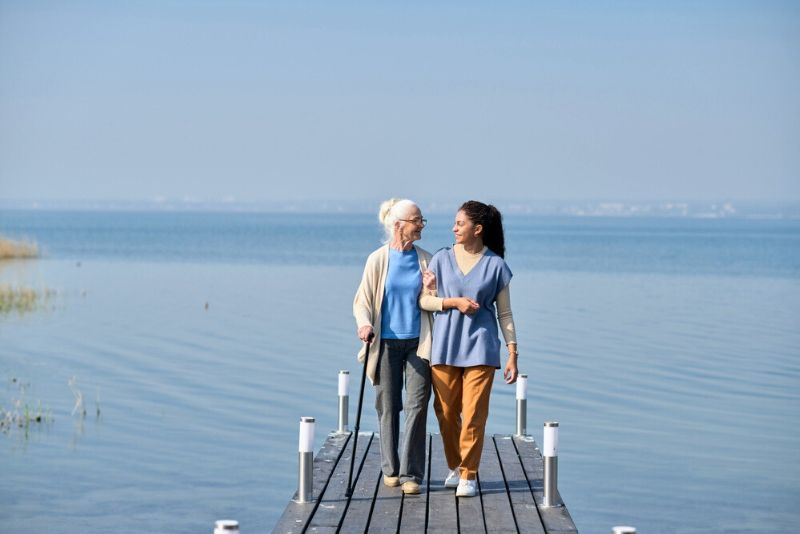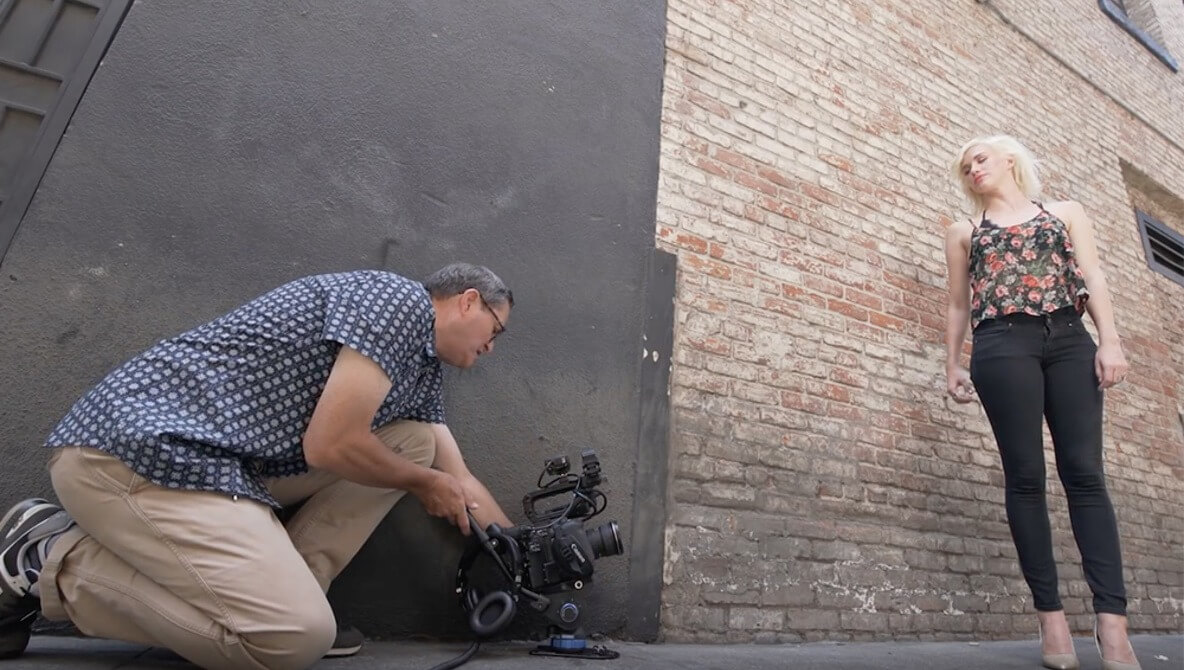It’s pretty beneficial to be aware of the industry’s top photography trends. Knowing what to shoot puts you ahead of the curve, whether for wedding photos, stock photos, or product photography.
Customers are continuously on the lookout for new experiences. They want to use photos that no one else has since it makes their photograph one-of-a-kind.
Camera angles refer to the position of the camera with respect to the subject. By adjusting the photography angles, you can thoroughly change the composition and perspective of a photograph.
So, what are the most popular photography angle ideas right now?
20 Different Photography Angles
1. Long Shot Photography Angle
The subject is captured in a broad view of their surroundings in a long shot. To set the setting, this sort of camera shot is usually applied. It provides a perspective to the viewers by observing how the subject interacts with their surroundings.
A full shot is a close-up variation of the long shot. This captures the subject’s overall look while also displaying the surroundings in the background.

A long shot captures the subject from a distance, showing the entire scene or environment. It aims to include the context and is perfect for depicting vast landscapes or large crowds.
2. Extreme Close-up Shot Photography Angle

Image source: istockphoto.com
A close-up shot concentrates on a specific part of the subject and aims to capture fine details or facial expressions. It adds familiarity and emphasis to the subject.
A feature of the subject covers the whole frame in an extreme close-up picture. It’s used to draw attention to specific traits or behaviors. For example, this view is most commonly used to catch a character’s eyes, lips, or fingers making a vital movement. Makeup photography needs a close-up shot.
3. Close-up Shot Photography Angle

A close-up photograph narrowly frames the subject’s face to draw the viewer’s attention to their expressions.
Due to the absence of any distracting objects, these images are excellent for connecting with the viewer and evoking emotional responses from the subject.
4. Medium Shot Photography Angle

A medium shot is used to disclose more information about the subject, which captures them from the waist up as it captures the subject’s hands and a portion of their surroundings.
It is the most effective method of capturing detailed motions while keeping a general perspective. As a result, the medium shot is among one of the most often photography angle ideas used.
The medium-long shot and the cowboy shot are the two most common variations of this technique. The medium-long shot is positioned in the middle of the long and medium shots.
It establishes a visual framework for the topic from the knees up. The cowboy shot, which cuts the frame at mid-thigh, was extensively used in Western films to display gun holsters on cowboys’ hips, and it is still used today.
5. Medium Close-up Shot Photography Angle
The medium close-up captures the subject’s whole body, starting from the chest up. This technique is typically utilized to capture enough information on the subject’s face while keeping them inside their immediate environment.
To maintain a sense of distance between the individuals, medium close-up views are employed throughout the film.

Image source: researchgate.net
6. Establishing Shot Photography Angle
The establishing shot is a vast view angle that is used to introduce a scene. It is used to set the scene for the action by introducing the environment in which it takes place.
Aerial views are frequently chosen for these scenarios because they provide an unmatched perspective of the surroundings.

Image source: unsplash.com
7. Bird’s-eye View Photography Angle
The term “bird’s eye view” or flat lay refers to a photograph taken from a high vantage point and is used to describe this sort of photograph.
As its name implies, it provides a viewpoint comparable to that experienced by birds while flying. Using this camera viewpoint, we may enhance the scale and movement of the scene.
The popularity of drones, which was previously only possible to a select group of filmmakers, is now available to videographers of all skill levels.

Image source: shotkit.com
8. Point of View Photography Angle
This shot depicts what the subject is looking at at the time of the photograph. It is used to draw attention to certain aspects or behaviors.
It is possible to put yourself in the shoes of the subject while using this sort of picture. Thus, their emotional attachment to the subject and setting are strengthened.

Image source: shutterstock.com
9. Worm’s-Eye View Photography Angle
The worm’s-eye view shot takes a look at an item or topic from below the earth’s surface. In photography, it is often employed to capture and put into perspective towering features in a picture, such as trees or skyscrapers, among other things.
The majority of the time, this sort of camera picture is taken from the subject’s perspective.

Image Source: flickr.com
10. Over the Shoulder Photography Angle
The subject is captured from behind another figure in an over-the-shoulder frame. The second character’s shoulder and a portion of their head are included in the shot.
Since it keeps both characters in the scene while concentrating on only one time, this camera position is most often used during discussion scenes.

Image source: bhphotovideo.com
11. Two Shot Photography Angle
A two-shot is a photograph that has two subjects in the frame. No requirement exists that they are nearby or get the same treatment as one another.
In many examples of a two-shot composition, one subject is positioned in the forefront while the other is behind.

Image source: studiobinder.com
12. Eye-Level Photography Angle
The eye-level picture is often regarded as the most natural camera angle today. This is because taking a photograph at eye level allows for a more external viewpoint of the scene.
This camera position can help the audience connect with the subject since it is similar to how we often observe individuals in our daily lives.

Image source: sydneyballif.weebly.com
13. High Angle Photography
A high-angle photo is obtained by aiming the camera down at the subject from a great distance.
It is possible to position the camera anywhere between just above the subject and slightly above the subject’s line of sight while taking this sort of image.

14. Low Angle Photography
A low-angle photo is made with the camera facing up when shooting from below the individual’s eye line. Since this is not a specific point of view, it might cause visual confusion in close-up pictures of the subject.
A low angle of view is often used with broader frames, such as medium or medium-close-up pictures, due to the above.

Image Source: Pinterest
15. Truck Shot Photography Angle
The camera is mounted to a device that travels smoothly down a horizontal track. These shots are most often utilized to trail an activity. Since the camera is moving, audiences will get the impression that they are also moving across the picture due to the camera movement.

Image Source: liveabout.com
16. Pan Shot Photography Angle
Panning is moving the camera horizontally on a fixed axis while maintaining focus on the subject. A pan shot is when the camera moves from one side to the other without changing its location.
This sort of camera shot is often used to follow an activity or provide viewers with a feeling of where they are.

Image Source: fundingsage.com
17. Tilt Shot Photography Angle
When shooting a film, the camera is tilted vertically on a permanent platform, which allows the audience to see the whole frame.
It is widely utilized to unveil new characters’ identities or establish a connection between an action and its performer. Additionally, tilt shots are sometimes used to provide a general perspective of the actor’s environment.

Image Source: dpchallenge.com
18. Rolling Shot Photography Angle
A roll camera movement is characterized by the rotation of the camera along its vertical axis. This sort of shot is one in which the camera is always pointing at the same target.
A typical application for this movement is in action situations or to convey a sense of illness or dizziness.

Image Source: health.clevelandclinic.org
19. Dolly Shot Photography Angle
A dolly shot is one in which the camera is mounted to a wheeled device that allows it to swing back and forth smoothly.
A camera dolly is a name given to the equipment itself. Dolly shots are typically used to follow a subject as they move about a location, usually in front of or behind them, to capture their movements.

Image Source: quora.com
20. Pedestal Shot Photography Angle
A pedestal shot is one in which the camera is moved vertically on a fixed point. Because of this movement, the audience’s view changes, but the same viewing angle is maintained at all times.
New features are gradually exposed to the viewer as the entire frame’s emphasis shifts from one point to another.

Bonus Tips for Beautiful Photography Angles
To elevate your image from a good capture into something professional and dramatic, you need to use a neutral density filter also known as an ND or neutral density filter).
ND filters are used to decrease the amount of light that is allowed to reach your camera’s sensor, which, in turn, flushes out your image in bright situations, allowing it to be correctly exposed to the subject matter.

Why are Camera Angles Important in Photography?
Camera angles play an essential role in telling stories through shots. Most photographers use these angles to capture images that stand out. Even though there is no magic formula to becoming a master photographer, mastering camera angles will certainly elevate your skills.
To begin, let’s define camera angles. Camera angles are the perspectives from which photographs are taken. An image’s frame determines how the subject and its surroundings are framed. Angles can convey a variety of emotions, stories, and aesthetics, but some are preferred due to their effectiveness.
Camera angles are important in photography because they add depth and dimension. Thus transforming flat images into captivating three-dimensional masterpieces.
Low camera angles can convey authority, emotion, and intrigue. Whereas high-angle shots can create a vulnerable atmosphere that captivates viewers, while low-angle shots evoke emotions that help tell a story.
Photography is all about conveying stories and expressing emotions in unique ways. Various camera angles can aid in this process, such as eye-level angles which help viewers connect with the subject on a personal level. Dutch angles, on the other hand, can introduce tension and unease in thriller or suspense genres.
Therefore it’s essential to choose angles that naturally frame the subject and draw the viewer’s eye to the intended focal point.
Final Words
In the initial stages of the photography profession, the most typical difficulty that new photographers have is figuring out how to utilize the camera they have bought.
It might be challenging to find out how to use the capabilities of your camera to its full potential to create amazing footage.
The most accessible approach to getting started with your new gadget is playing with it and starting with something basic.
A beautiful photo does not necessitate using all of the features on your camera; instead, learning how to take fundamental photography photos and use different camera angles will suffice in most cases.
FAQ
What are Photography Angles?
Photography angles refer to the various positions and angles from which a photo is taken. It commonly involves changing the camera angles to define the composition, perspective, and overall impact of the image.
Why Camera Angles are Important?
The importance of camera angles lies in their ability to significantly impact the mood, storytelling, and visual appeal of an image. Varying camera angles can elicit diverse emotions and communicate distinct messages.
What are Some Basic Camera Shots?
Some basic camera shots include wide shots, close-up shots, medium shots, and extreme close-up shots. Every shot serves a specific purpose and contributes to the overall composition of the image.
What is the Eye Level Angles in Photography?
The eye level angle in photography refers to capturing subjects from the same height as the viewer’s eyes. It creates a sense of familiarity and realism, as it mimics the perspective of the viewer.
What is a Dutch Angle in Photography?
Dutch angle, also known as a canted angle, is a tilted camera angle where the horizon line is not level. This angle is often used to create visual tension, unease, or a sense of disorientation in the viewer.
What is a High-angle Shot in Photography?
A high-angle shot is taken from a higher position than the subject. It is often used to depict the subject as vulnerable, feeble, or insufficient. It can also provide a different perspective and create a sense of depth in the image.
What is a Low-angle Shot in Photography?
A low-angle shot is taken from a lower position than the subject. This angle is often used to make the subject appear powerful, dominant, or heroic. It can also add a sense of grandeur and drama to the image.
What is the Relation Between Camera Angles and Types of Photography?
Different types of photography require different camera angles to effectively capture the subject matter. For example, portrait photography may often use eye-level angles to establish a personal connection, while landscape photography may use a wide-angle shot to capture the vastness of the scenery.


